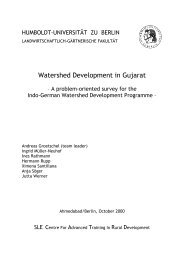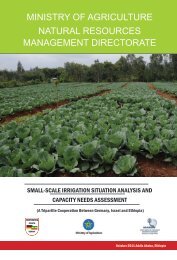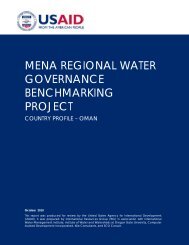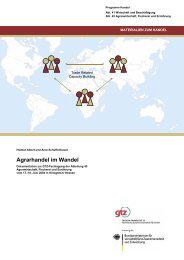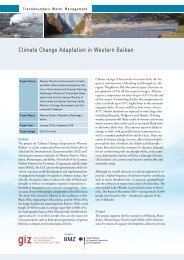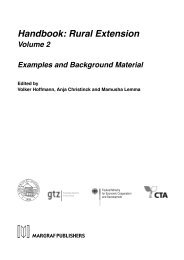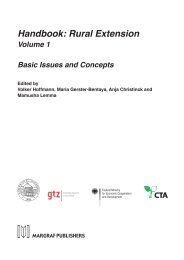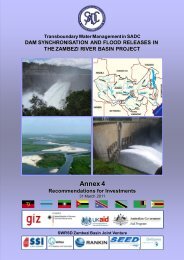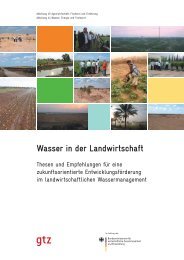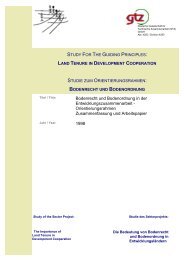Farming in the - WordPress.com
Farming in the - WordPress.com
Farming in the - WordPress.com
Create successful ePaper yourself
Turn your PDF publications into a flip-book with our unique Google optimized e-Paper software.
Analysis of <strong>the</strong> agricultural situation <strong>in</strong> Azraq Bas<strong>in</strong><br />
German-Jordanian Programme “Management of Water Resources”<br />
37<br />
<strong>Farm<strong>in</strong>g</strong> system<br />
Equipments<br />
and <strong>in</strong>puts<br />
Workers<br />
Repartition of<br />
production costs<br />
Profitability<br />
Remarks<br />
Representativeness<br />
of our sample<br />
Professional farms. Olive tree + alfalfa (+ fruit trees)<br />
Most farms are well equipped, with even specific accessories for alfalfa.<br />
Some have <strong>in</strong>vested <strong>in</strong> central pivot irrigation systems for alfalfa.<br />
At least 2 permanent workers on <strong>the</strong> farm + daily workers hired for each<br />
cut of alfalfa.<br />
Average costs<br />
= 240 JD/du<br />
Average for all farms<br />
work<strong>in</strong>g on diesel<br />
work<strong>in</strong>g with electricity<br />
% %<br />
water cost energy cost<br />
%<br />
labour cost<br />
%<br />
<strong>in</strong>put cost<br />
4% 47% 25% 25%<br />
1% 71% 15% 13%<br />
4% 53% 15% 28%<br />
High production costs are due to very high cost of pump<strong>in</strong>g of large<br />
quantities of water us<strong>in</strong>g diesel pumps and high use of agro-<strong>in</strong>puts used<br />
on alfalfa.<br />
Economical results are very different from farm to farm. Most of <strong>the</strong>se<br />
farms are generally <strong>in</strong> deficit. However, <strong>the</strong>y make profit from alfalfa, <strong>the</strong>y<br />
harvest up to 10 cuts per year and make around 60 JD/du per cut<br />
(production costs not deducted). A successful farm earns around 85<br />
JD/du/year consider<strong>in</strong>g all crops on <strong>the</strong> whole farm (as <strong>in</strong><strong>com</strong>e, production<br />
costs not deducted).<br />
All owners are entrepreneurs and have o<strong>the</strong>r <strong>in</strong>vestments <strong>in</strong> o<strong>the</strong>r<br />
sectors.<br />
Accord<strong>in</strong>g to bibliography, <strong>the</strong> yield of alfalfa <strong>in</strong> Azraq is very low (1/3 of<br />
maximal yield, which is around 6 tons of dry alfalfa/du/yr accord<strong>in</strong>g to<br />
one of <strong>the</strong> farmers), might be due to very high water sal<strong>in</strong>ity.<br />
22% of <strong>the</strong> surveyed farms <strong>in</strong> Azraq belong to this type (8 of <strong>the</strong> 36),<br />
which would mean 133 farms <strong>in</strong> Azraq belong to this category. We th<strong>in</strong>k<br />
this type slightly over estimates <strong>the</strong> reality 53 . Indeed, with this proportion,<br />
it would represent <strong>in</strong> total 36000 du, or 40% of <strong>the</strong> irrigated agricultural<br />
land <strong>in</strong> Azraq.<br />
Our sample underestimates <strong>the</strong> number of farms that specialise <strong>in</strong><br />
vegetable 54 . Indeed, we visited only 1 farm planted with vegetables. Most<br />
vegetable farms <strong>in</strong> Azraq are plant<strong>in</strong>g for early production <strong>in</strong> March or<br />
April, under m<strong>in</strong>i tunnels. They plant only one rotation each year, and <strong>the</strong><br />
farms were not planted dur<strong>in</strong>g <strong>the</strong> period of <strong>the</strong> <strong>in</strong>terviews.<br />
Farms types and <strong>the</strong>ir ma<strong>in</strong> characteristics <strong>in</strong> Azraq are summarised <strong>in</strong><br />
<strong>the</strong> table below:<br />
Production systems<br />
Small olive tree<br />
farms (with fruit tree<br />
<strong>in</strong>tercropp<strong>in</strong>g)<br />
Professional<br />
olive tree farms<br />
Professional olive<br />
tree farms with<br />
diversification (grapes,<br />
pomegranate…)<br />
Olive tree farms with<br />
diversification to<br />
alfalfa<br />
Vegetable farms<br />
Average<br />
size<br />
% of nb<br />
of Azraq<br />
farms<br />
% Total<br />
irrigated area<br />
<strong>in</strong> Azraq<br />
40 du 42 % 11 %<br />
Average<br />
water<br />
consumption<br />
200 du 19 % 25 % 905 m 3 /du/y<br />
Average<br />
yearly profit<br />
1160 m 3 /du/y<br />
-Surf: 1300 m 3<br />
- OT: 900 m 3 9 JD/du/y<br />
20 JD/du/y<br />
100 if productive<br />
240 du 14 % 22 % 390 m 3 /du/y 130 JD/du/y<br />
270 du 22 % 39 % 1040 m 3 /du/y<br />
variable<br />
85 JD/du/y<br />
170 du 3 % 3 % 1400 m 3 /du/y Not enough<br />
data<br />
53 Accord<strong>in</strong>g to MoA data <strong>in</strong> Azraq (2010), only 4% of <strong>the</strong> irrigated area is planted with alfalfa.<br />
54 MoA <strong>in</strong> Azraq (data 2010) estimates that area planted with vegetables represent 9% of total irrigated area.



